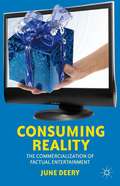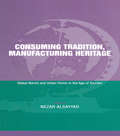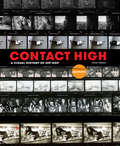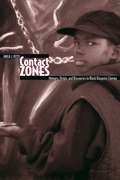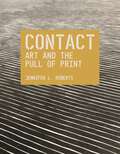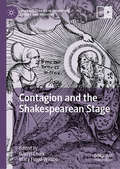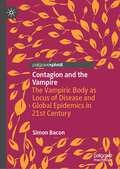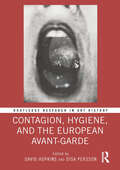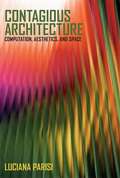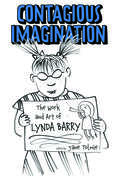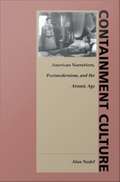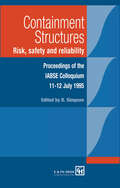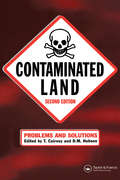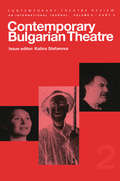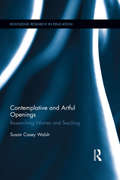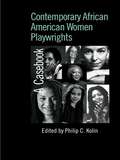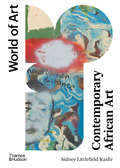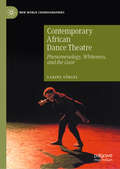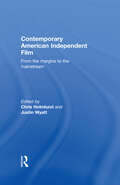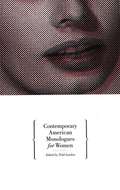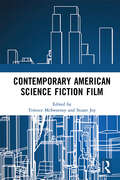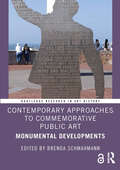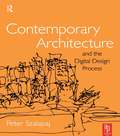- Table View
- List View
Consuming Reality
by June DeeryEngaging in a comprehensive examination of reality TV's advertising and promotional strategies, as well as the commodification of viewers, Consuming Reality dissects the unique and startling relation between mediation and consumption.
Consuming Stories: Kara Walker and the Imagining of American Race
by Rebecca PeabodyIn Consuming Stories, Rebecca Peabody uses the work of contemporary American artist Kara Walker to investigate a range of popular storytelling traditions with roots in the nineteenth century and ramifications in the present. Focusing on a few key pieces that range from a wall-size installation to a reworked photocopy in an artist's book and from a theater curtain to a monumental sculpture, Peabody explores a significant yet neglected aspect of Walker's production: her commitment to examining narrative depictions of race, gender, power, and desire.
Consuming Tradition, Manufacturing Heritage: Global Norms and Urban Forms in the Age of Tourism
by Nezar AlSayyadFrom the Grand Tour to today's packages holidays, the last two centuries have witnessed an exponential growth in travel and tourism and, as the twenty-first century unfolds, people of every class and from every country will be wandering to every part of the planet.Meanwhile tourist destinations throughout the world find themselves in ever more fierce competition - those places marginalized in today's global industrial and information economy perceiving tourism as perhaps the only means of surviving. But mass tourism has raised the local and international passions as people decry the irreversible destruction of traditional places and historic sites.Against these trends and at a time when standardized products and services are marketed worldwide, there is an increasing demand for built environments that promise unique cultural experiences. This has led many nations and groups to engage in the parallel processes of facilitating the consumption of tradition and of manufacturing tradition.The contributors to this volume - drawn from a wide range of disciplines - address these themes within the following sections: Traditions and Tourism: Rethinking the "Other"; Imaging and Manufacturing Heritage; Manufacturing and Consuming: Global and Local. Their studies, dealing with very different times, environments and geographic locales, will shed new light on how tourist 'gaze' transforms the reality of built spaces into cultural imagery.
Contact High: A Visual History of Hip-Hop
by Questlove Vikki TobakAn inside look at the work of hip-hop photographers told through their most intimate diaries—their contact sheets. Featuring rare outtakes from over 100 photoshoots alongside interviews and essays from industry legends, Contact High: A Visual History of Hip-Hop takes readers on a chronological journey from old-school to alternative hip-hop and from analog to digital photography. The ultimate companion for music and photography enthusiasts, Contact High is the definitive history of hip-hop’s early days, celebrating the artists that shaped the iconic album covers, t-shirts and posters beloved by hip-hop fans today. With essays from BILL ADLER, RHEA L. COMBS, FAB 5 FREDDY, MICHAEL GONZALES, YOUNG GURU, DJ PREMIER, and RZA
Contact Zones: Memory, Origin, and Discourses in Black Diasporic Cinema
by Sheila J. PettyCreated at the crossroads of slavery, migration, and exile, and comprising a global population, the black diaspora is a diverse space of varied histories, experiences, and goals. Likewise, black diasporic film tends to focus on the complexities of transnational identity, which oscillates between similarity and difference and resists easy categorization. In Contact Zones author Sheila J. Petty addresses a range of filmmakers, theorists, and issues in black diasporic cinema, highlighting their ongoing influences on contemporary artistic and theoretical discourses. Petty examines both Anglophone and Francophone films and theorists, divided according to this volume's three thematic sections--Slavery, Migration and Exile, and Beyond Borders. The feature films and documentaries considered--which include Sankofa, Daughters of the Dust, The Man by the Shore, and Rude, among others--represent a wide range of cultures and topics. Through close textual analysis that incorporates the work of well-known diasporic thinkers like W. E. B. DuBois, Aimé Césaire, and Frantz Fanon along with contemporary notables such as Molefi Kete Asante, bell hooks, Clenora Hudson-Weems, René Depestre, Paul Gilroy, and Rinaldo Walcott, Petty details the unique ways in which black diasporic films create meaning. By exploring a variety of African American, Caribbean, Black British, and African Canadian perspectives, Contact Zones provides a detailed survey of the diversity and vitality of black diasporic contributions to cinema and theory. This volume will be a welcome addition to the libraries of scholars and students of film studies and Africana studies.
Contact: Art and the Pull of Print (The A. W. Mellon Lectures in the Fine Arts #70)
by Jennifer L. RobertsA leading art historian presents a new grammar for understanding the meaning and significance of printIn process and technique, printmaking is an art of physical contact. From woodcut and engraving to lithography and screenprinting, every print is the record of a contact event: the transfer of an image between surfaces, under pressure, followed by release. Contact reveals how the physical properties of print have their own poetics and politics and provides a new framework for understanding the intelligence and continuing relevance of printmaking today.The seemingly simple physics of printmaking brings with it an array of metamorphoses that give expression to many of the social and conceptual concerns at the heart of modern and contemporary art. Exploring transformations such as reversal, separation, and interference, Jennifer Roberts explores these dynamics in the work of Christiane Baumgartner, David Hammons, Edgar Heap of Birds, Jasper Johns, Corita Kent, Glenn Ligon, Julie Mehretu, Robert Rauschenberg, and many other leading artists who work at the edge of the medium and beyond.Focusing on the material and spatial transformations of the printmaking process rather than its reproducibility, this beautifully illustrated book explores the connections between print, painting, and sculpture, but also between the fine arts, industrial arts, decorative arts, and domestic arts. Throughout, Roberts asks what artists are learning from print, and what we, in turn, can learn from them.Published in association with the Center for Advanced Study in the Visual Arts, National Gallery of Art, Washington
Contagion and the Shakespearean Stage (Palgrave Studies in Literature, Science and Medicine)
by Mary Floyd-Wilson Darryl ChalkThis collection of essays considers what constituted contagion in the minds of early moderns in the absence of modern germ theory. In a wide range of essays focused on early modern drama and the culture of theater, contributors explore how ideas of contagion not only inform representations of the senses (such as smell and touch) and emotions (such as disgust, pity, and shame) but also shape how people understood belief, narrative, and political agency. Epidemic thinking was not limited to medical inquiry or the narrow study of a particular disease. Shakespeare, Thomas Middleton, Ben Jonson, Thomas Dekker and other early modern writers understood that someone might be infected or transformed by the presence of others, through various kinds of exchange, or if exposed to certain ideas, practices, or environmental conditions. The discourse and concept of contagion provides a lens for understanding early modern theatrical performance, dramatic plots, and theater-going itself.
Contagion and the Vampire: The Vampiric Body as Locus of Disease and Global Epidemics in 21st Century
by Simon BaconThis book examines how the vampire has always been connected to ideas of infection, pollution and disease—even more so in the 21st century where it expresses the horrors of unseen and unstoppable disease and the foreboding and anxiety that accompany viral outbreaks and wider epidemics. Here the vampire gives physical form to the contagion and associated anxieties around the perceived causes and spread of disease, where it can take on many forms from animal to pestilential particulate matter, creeping shadows and even malignant weather systems. If blood is life, it is the body of the vampire that is death. This timely study looks at how and why the vampire continues to fulfil this function and posits that the true patient zero in the 21st century is no longer the dangerous, ancient, outsider from the East but is the undying monster that is Western culture itself.
Contagion, Hygiene, and the European Avant-Garde (Routledge Research in Art History)
by David Hopkins Disa PerssonThis interdisciplinary collection of essays brings together scholars in the fields of art history, theatre, visual culture, and literature to explore intersections between the European avant-garde (c. 1880–1945) and themes of health and hygiene, such as illness, contagion, cleanliness, and contamination. Examining the artistic oeuvres of some of the canonical names of modern art – including Edgar Degas, Edvard Munch, Pablo Picasso, George Orwell, Marcel Duchamp, and Antonin Artaud – this book investigates instances where the heightened political, social, and cultural currencies embedded within issues of hygiene and contagion have been mobilised, and subversively exploited, to fuel the critical strategy at play. This edited volume promotes an interdisciplinary and socio-historically contextualised understanding of the criticality of the avant-garde gesture and cultivates scholarship that moves beyond the limits of traditional academic subjects to produce innovative and thought-provoking connections and interrelations across various fields. The book will be of interest to scholars working in art history, literature, theatre, cultural studies, modern history, medical humanities, and visual culture.
Contagious Architecture: Computation, Aesthetics and Space
by Luciana ParisiIn Contagious Architecture, Luciana Parisi offers a philosophical inquiry into the status of the algorithm in architectural and interaction design. Her thesis is that algorithmic computation is not simply an abstract mathematical tool but constitutes a mode of thought in its own right, in that its operation extends into forms of abstraction that lie beyond direct human cognition and control. These include modes of infinity, contingency, and indeterminacy,as well as incomputable quantities underlying the iterative process of algorithmic processing. The main philosophical source for the project is Alfred North Whitehead, whose process philosophy is specifically designed to provide a vocabulary for "modes of thought"exhibiting various degrees of autonomy from human agency even as they are mobilized by it. Because algorithmic processing lies at the heart of the design practices now reshaping our world -- from the physical spaces of our built environment to the networked spaces of digital culture -- the nature of algorithmic thought is a topic of pressing importance that reraises questions of control and,ultimately, power. Contagious Architecture revisits cybernetic theories of control and information theory's notion of the incomputable in light of this rethinking of the role of algorithmic thought. Informed by recent debates in political and cultural theory around the changing landscape of power, it links the nature of abstraction to a new theory of power adequate to the complexities of the digital world.
Contagious Imagination: The Work and Art of Lynda Barry (Critical Approaches to Comics Artists Series)
by Glenn WillmottContributions by Frederick Luis Aldama, Melissa Burgess, Susan Kirtley, Rachel Luria, Ursula Murray Husted, Mark O’Connor, Allan Pero, Davida Pines, Tara Prescott-Johnson, Jane Tolmie, Rachel Trousdale, Elaine Claire Villacorta, and Glenn WillmottLynda Barry (b. 1956) is best known for her distinctive style and unique voice, first popularized in her underground weekly comic Ernie Pook’s Comeek. Since then, she has published prolifically, including numerous comics, illustrated novels, and nonfiction books exploring the creative process. Barry’s work is genre- and form-bending, often using collage to create what she calls “word with drawing” vignettes. Her art, imaginative and self-reflective, allows her to discuss gender, race, relationships, memory, and her personal, everyday lived experience. It is through this experience that Barry examines the creative process and offers to readers ways to record and examine their own lives. The essays in Contagious Imagination: The Work and Art of Lynda Barry, edited by Jane Tolmie, study the pedagogy of Barry’s work and its application academically and practically. Examining Barry’s career and work from the point of view of research-creation, Contagious Imagination applies Barry’s unique mixture of teaching, art, learning, and creativity to the very form of the volume, exploring Barry’s imaginative praxis and offering readers their own. With a foreword by Frederick Luis Aldama and an afterword by Glenn Willmott, this volume explores the impact of Barry’s work in and out of the classroom. Divided into four sections—Teaching and Learning, which focuses on critical pedagogy; Comics and Autobiography, which targets various practices of rememorying; Cruddy, a self-explanatory category that offers two extraordinary critical interventions into Barry criticism around a challenging text; and Research-Creation, which offers two creative, synthetic artistic pieces that embody and enact Barry’s own mixed academic and creative investments—this book offers numerous inroads into Barry’s idiosyncratic imagination and what it can teach us about ourselves.
Containment Culture: American Narratives, Postmodernism, and the Atomic Age
by Alan NadelAlan Nadel provides a unique analysis of the rise of American postmodernism by viewing it as a breakdown in Cold War cultural narratives of containment. These narratives, which embodied an American postwar foreign policy charged with checking the spread of Communism, also operated, Nadel argues, within a wide spectrum of cultural life in the United States to contain atomic secrets, sexual license, gender roles, nuclear energy, and artistic expression. Because these narratives were deployed in films, books, and magazines at a time when American culture was for the first time able to dominate global entertainment and capitalize on global production, containment became one of the most widely disseminated and highly privileged national narratives in history. Examining a broad sweep of American culture, from the work of George Kennan to Playboy Magazine, from the movies of Doris Day and Walt Disney to those of Cecil B. DeMille and Alfred Hitchcock, from James Bond to Holden Caulfield, Nadel discloses the remarkable pervasiveness of the containment narrative. Drawing subtly on insights provided by contemporary theorists, including Baudrillard, Foucault, Jameson, Sedgwick, Certeau, and Hayden White, he situates the rhetoric of the Cold War within a gendered narrative powered by the unspoken potency of the atom. He then traces the breakdown of this discourse of containment through such events as the Bay of Pigs invasion and the Free Speech Movement at Berkeley, and ties its collapse to the onset of American postmodernism, typified by works such as Catch-22 and The Man Who Shot Liberty Valence. An important work of cultural criticism, Containment Culture links atomic power with postmodernism and postwar politics, and shows how a multifarious national policy can become part of a nation's cultural agenda and a source of meaning for its citizenry.
Containment Structures: Proceedings of the IABSE Henderson Colloquium
by B. SimpsonThis book brings together contributions from some of the leading researchers and practising engineers in the field of silos and containment structures, and is derived from a specially invited colloquium on the subject. As well as case studies, it includes reviews dealing with safety and risk in design and operation of these structures.
Contaminated Land: Problems and Solutions, Second Edition
by Griselda PollockContaminated land is a problem both in the short and long term as it cannot be used without remediation. The investigation and analysis of the problem, along with the legal responsibilities surrounding the issues, continue to present difficulties to those wishing to use or develop a contaminated site. Since publication of the 1st edition, the area
Contemp Bugarian Theatre 2
by StefanovaFirst Published in 1998. Routledge is an imprint of Taylor & Francis, an informa company.
Contemplating the Ancients: Aesthetic and Social Issues in Early Chinese Portraiture
by Audrey SpiroThis title is part of UC Press's Voices Revived program, which commemorates University of California Press’s mission to seek out and cultivate the brightest minds and give them voice, reach, and impact. Drawing on a backlist dating to 1893, Voices Revived makes high-quality, peer-reviewed scholarship accessible once again using print-on-demand technology. This title was originally published in 1990.
Contemplative and Artful Openings: Researching Women and Teaching (Routledge Research in Education #193)
by Susan Casey WalshHighlighting an arts-based inquiry process that involves contemplation, mindful awareness, and artful writing, this book explores women’s difficult experiences in teaching. It weaves a strong autobiographical thread with artifacts from several research projects with female teachers. By linking innovative approaches to research that involve visual images and poetic writing with feminist poststructuralist theories and Buddhist-inspired practices, Walsh offers new understandings about what it means to be critical in research and teaching—and also what transformation, both social and personal, might entail.
Contemporary African American Women Playwrights: A Casebook (Casebooks on Modern Dramatists)
by Philip C. Kolin'The impressive array of scholars gathered in this collection, all experts in the field, read the plays with nuance and situate them deftly within their cultural and historical contexts. Scholars of contemporary theater and drama and of African American literature will find value in this engaging collection.' – Choice 'For students and scholars of American theatre and drama generally and African American theatre and drama most particularly, this is an extremely valuable critical source.' – Harry Elam, Stanford University, USA In the last fifty years, American and World theatre has been challenged and enriched by the rise to prominence of numerous female African American dramatists. Contemporary African American Women Playwrights is the first critical volume to explore the contexts and influences of these writers, and their exploration of black history and identity through a wealth of diverse, courageous and visionary dramas. Kolin compiles a wealth of new essays, comprising: Yale scholar David Krasner on the dramatic legacy of Lorraine Hansberry, Zora Neale Hurston, Marita Bonner and Georgia Douglas Johnson individual chapters devoted to: Alice Childress, Sonia Sanchez, Adrienne Kennedy, Ntozake Shange, Pearl Cleage, Aishah Rahman, Glenda Dickerson, Anna Deavere Smith and Suzan Lori-Parks an essay and accompanying interview with Lynn Nottage comprehensive discussion of attendant theatrical forms, from choreopoems and surrealistic plays, to documentary theatre and civil rights dramas, and their use in challenging racial and gender hierarchies. Contributors: Brandi Wilkins Catanese, Soyica Diggs, James Fisher, Freda Scott Giles, Joan Wylie Hall, Philip C. Kolin, David Krasner, Sandra G. Shannon, Debby Thompson, Beth Turner and Jacqueline Wood.
Contemporary African Art: Second Edition (World of Art #0)
by Sidney Littlefield KasfirA revised edition of this seminal title, surveying the diverse, ever-evolving field of contemporary African art from the 1950s to today, illustrated in color throughout. Contemporary African art has grown out of the diverse histories and cultural heritage of the African continent and its diaspora. It is not characterized by one particular style, technique, or theme, but by a bricolage-like attitude toward art making, incorporating and building upon the structures from which older, pre- colonial and colonial genres were made. In this revised and updated edition of Contemporary African Art, Sidney Littlefield Kasfir examines the major themes, developments, and accomplishments in African art of the twentieth and twenty-first centuries. Organized thematically, the book includes new chapters on the history of African photography and the growth of the global art market, alongside significant discussions of patronage, mediation, artistic training, and national and diaspora identities. Generously illustrated throughout, including work by artists such as El Anatsui, Yinka Shonibare, William Kentridge, and Ibrahim El-Salahi, the book draws on interviews with many contemporary artists and art world professionals. Contemporary African Art is a fascinating, comprehensive survey of art from the African continent and its global diaspora.
Contemporary African Dance Theatre: Phenomenology, Whiteness, and the Gaze (New World Choreographies)
by Sabine SörgelThis book is the first to consider contemporary African dance theatre aesthetics in the context of phenomenology, whiteness, and the gaze. Rather than a discussion of African dance per se, the author challenges hegemonic perceptions of contemporary African dance theatre to interrogate the extent to which white supremacy and privilege weave through capitalist necropolitics and determine our perception of contemporary African dance theatre today. Multiple aesthetic strategies are discussed throughout the book to account for the affective experience of ‘un-suturing’ that touches white spectatorship and colonial guilt at their core. The critical analysis covers a broad range of dance choreography by artists from the Democratic Republic of Congo, Ivory Coast, South Africa, Canada, Europe, and the US as they travel, create, and show their works internationally to global audiences to contest racial divides and white supremacist politics.
Contemporary American Independent Film: From the Margins to the Mainstream
by Chris Holmlund Justin WyattFrom Easy Rider to The Blair Witch Project, this book is a comprehensive examination of the independent film scene. Exploring the uneasy relationship between independent films and the major studios, the contributors trace the changing ideas and definitions of independent cinema, and the diversity of independent film practices. They consider the ways in which indie films are marketed and distributed, and how new technologies such as video, cable and the internet, offered new opportunities for filmmakers to produce and market independent films. Turning to the work of key auteurs such as John Sayles and Haile Gerima, contributors ask whether independent filmmakers can also be stars, and consider how indie features like Boys Don't Cry and Shopping for Fangs address issues of gender, sexuality and ethnicity normally avoided by Hollywood. For all students of film studies and American studies, this cultural journey through independent film history will be an absolute must read.
Contemporary American Monologues for Women
by Todd LondonAudition monologues for female characters selected from recent works by American playwrights including Tony Kushner, Jon Robin Baitz, Constance Congdon, Paula Vogel, Donald Margulies, Emily Mann, Eric Bogosian, Nicky Silver, and others. Unique to the TCG monologue series is a bibliography of other works by the playwrights included.
Contemporary American Science Fiction Film
by Terence McSweeneyContemporary American Science Fiction Film explores and interrogates a diverse variety of popular and culturally relevant American science fiction films made in the first two decades of the new millennium, offering a ground-breaking investigation of the impactful role of genre cinema in the modern era. Placing one of the most popular and culturally resonant American film genres broadly within its rich social, historical, industrial, and political context, the book interrogates some of the defining critical debates of the era via an in-depth analysis of a range of important films. An international team of authors draw on case studies from across the science fiction genre to examine what these films can tell us about the time period, how the films themselves connect to the social and political context, how the fears and anxieties they portray resonate beyond the screen, and how the genre responds to the shifting coordinates of the Hollywood film industry. Offering new insights and perspectives on the cinematic science fiction genre, this volume will appeal primarily to scholars and students of film, television, cultural and media studies, as well as anyone interested in science fiction and speculative film.
Contemporary Approaches to Commemorative Public Art: Monumental Developments (Routledge Research in Art History)
by Brenda SchmahmannIn this collection, a diverse range of international contributors examine commemorative monuments from the late twentieth and twenty-first centuries. The book reveals how those monuments enable new perspectives and understanding of histories as well as a heightened involvement of viewers through not simply their subject matter but also, most crucially, their actual form and design. While some contributors explore new approaches to the art of commemoration that artists and designers have deployed in recent monuments, others examine how artists have undertaken creative engagements with historical statuary and sites, using these interventions to offer critique and commentary. Additionally, the contributions consider the impact of political change on ways in which an inherited commemorative landscape is interpreted and negotiated. Questions considered by the contributions include: How might new monuments be shaped and how might they function differently from those of the past? Is there a place for portraiture in the contemporary commemorative landscape? Should commemorative monuments be envisaged as permanent fixtures or are temporary approaches more viable? How effectively have artists disrupted the meanings of historical monuments and sites through installation, performance, video and other media? How has political change played out at historical sites, affecting how commemorative monuments from prior dispensations are understood in the 2020s?This collection will be of value to researchers in Art History, Visual Studies and Heritage Studies, as well as scholars in all disciplines and fields who are interested in public art, public memory and the politics of commemoration.
Contemporary Architecture and the Digital Design Process
by Peter SzalapajContemporary Architecture and the Digital Design Process introduces the reader to new developments in the computer modelling of design form in contemporary architectural practice through a series of detailed case studies. The book illustrates how evolving design practices use and exploit the potential of new computing technologies in a wide range of areas and application.A central thesis of this book is that technology follows design demand, rather than design adjusting to available new technology. Designers are not merely passive recipients of prescribed computing tools and techniques. Instead, they are increasingly able to express their intuitive design ideas through the rational medium of computing.The book features several contemporary building projects, each of which introduces a range of CAD and computing issues based upon the work of creative architectural and engineering design practices. These include the offices of Frank O. Gehry, Peter Cook and Colin Fournier, Anthony Hunt Associates, Peter Hubner, Szyskowitz-Kowalski, and Faulkner Brown. All these examples show what architects need to know and the skills they need to acquire to use advanced CAD technology.
